Habitat Preferences and Trophic Position of Brachydiplax chalybea flavovittata Ris, 1911 (Insecta: Odonata) Larvae in Youngsan River Wetlands of South Korea
Abstract
1. Introduction
2. Materials and Methods
2.1. Study Area
2.2. Monitoring Strategy
2.3. Stable Isotope Analysis
2.4. Data Analysis
3. Results
3.1. Environmental Variables and Odonata Larvae Distribution
3.2. Distribution of Brachydiplax chalybea flavovittata Larvae in Different Microhabitat Types
3.3. Stable Nitrogen Isotope Analysis of Odonata Larvae
4. Discussion
4.1. Influence of Environmental Variables on Odonata Larvae Distribution
4.2. Microhabitat Preference of Brachydiplax chalybea flavovittata Larvae
4.3. Impact of Brachydiplax chalybea flavovittata Settlement on Native Odonata Comunities
4.4. Geographical Extension and Settlement of Brachydiplax chalybea flavovittata Larvae in South Korea
5. Conclusions
Author Contributions
Funding
Conflicts of Interest
References
- Ho, S.S.; Bond, N.R.; Lake, P.S. Comparing food-web impacts of a native invertebrate and an invasive fish as predators in small floodplain wetlands. Mar. Freshw. Res. 2011, 62, 372–382. [Google Scholar] [CrossRef]
- Riesch, R. The role of habitat type and nutrient quality on invertebrate dispersal and diversity. Proc. Okla. Acad. Sci. 2015, 87, 89–94. [Google Scholar]
- Kuczyńska-Kippen, N.M.; Nagengast, B. The influence of the spatial structure of hydromacrophytes and differentiating habitat on the structure of rotifer and cladoceran communities. Hydrobiologia 2006, 559, 203–212. [Google Scholar] [CrossRef]
- Choi, J.Y.; Jeong, K.S.; Kim, S.K.; La, G.H.; Chang, K.H.; Joo, G.J. Role of macrophytes as microhabitats for zooplankton community in lentic freshwater ecosystems of South Korea. Ecol. Inform. 2014, 24, 177–185. [Google Scholar] [CrossRef]
- Butler, R.G.; Demaynadier, P.G. The significance of littoral and shoreline habitat integrity to the conservation of lacustrine damselflies (Odonata). J. Insect Conserv. 2008, 12, 23–36. [Google Scholar] [CrossRef]
- Palmer, T.M. Spatial habitat heterogeneity influences competition and coexistence in an African acacia ant guild. Ecology 2003, 84, 2843–2855. [Google Scholar] [CrossRef]
- Tews, J.; Brose, U.; Grimm, V.; Tielbörger, K.; Wichmann, M.C.; Schwager, M.; Jeltsch, F. Animal species diversity driven by habitat heterogeneity/diversity: The importance of keystone structures. J. Biogeogr. 2004, 31, 79–92. [Google Scholar] [CrossRef]
- Choi, J.Y.; Jeong, K.S.; Kim, S.K.; Joo, G.J. Impact of habitat heterogeneity on the biodiversity and density of the zooplankton community in shallow wetlands (Upo wetlands, South Korea). Oceanol. Hydrobiol. Stud. 2016, 45, 485–492. [Google Scholar] [CrossRef]
- Choi, J.Y.; Kim, S.K. Responses of Rotifer Community to Microhabitat Changes Caused by summer-Concentrated Rainfall in a Shallow Reservoir, South Korea. Diversity 2020, 12, 113. [Google Scholar] [CrossRef]
- Bazzaz, F.A. Plant species diversity in old field successional ecosystems in Southern Illinois. Ecology 1975, 56, 485–488. [Google Scholar] [CrossRef]
- Cyr, H. Effects of wave disturbance and substrate slope on sediment characteristics in the littoral zone of small lakes. Can. J. Fish. Aquat. Sci. 1998, 55, 967–976. [Google Scholar] [CrossRef]
- Sabo, M.J.; Bryan, C.F.; Kelso, W.E.; Rutherford, D.A. Hydrology and aquatic habitat characteristics of a riverine swamp: I. Influence of flow on water temperature and chemistry. Regul. Rivers Res. Manag. 1999, 15, 505–523. [Google Scholar] [CrossRef]
- Spänhoff, B.; Riss, W.; Jäkel, P.; Dakkak, N.; Meyer, E.I. Effects of an experimental enrichment of instream habitat heterogeneity on the stream bed morphology and chironomid community of a straightened section in a sandy lowland stream. Environ. Manag. 2006, 37, 247–257. [Google Scholar] [CrossRef] [PubMed]
- Padial, A.A.; Thomaz, S.M.; Agostinho, A.A. Effects of structural heterogeneity provided by the floating macrophyte Eichhornia azurea on the predation efficiency and habitat use of the small Neotropical fish Moenkhausia sanctaefilomenae. Hydrobiologia 2009, 624, 161–170. [Google Scholar] [CrossRef]
- Thomaz, S.M.; Dibble, E.D.; Evangelista, L.R.; Higuti, J.; Bini, L.M. Influence of aquatic macrophyte habitat complexity on invertebrate abundance and richness in tropical lagoons. Freshw. Biol. 2008, 53, 358–367. [Google Scholar] [CrossRef]
- Thomaz, S.M.; Cunha, E.R.D. The role of macrophytes in habitat structuring in aquatic ecosystems: Methods of measurement, causes and consequences on animal assemblages’ composition and biodiversity. Acta Limnol. Bras. 2010, 22, 218–236. [Google Scholar] [CrossRef]
- Manatunge, J.; Asaeda, T.; Priyadarshana, T. The influence of structural complexity on fish-zooplankton interactions: A study using artificial submerged macrophytes. Environ. Biol. Fishes 2000, 58, 425–438. [Google Scholar] [CrossRef]
- Jeppesen, E.; Søndergaard, M.; Prtersen, B.; Eriksen, R.B.; Hammershøj, M.; Mortensen, E.; Jensen, J.P.; Have, A. Does the impact of nutrients on the biological structure and function of brackish and freshwater lakes differ? Hydrobiologia 1994, 27, 15–30. [Google Scholar] [CrossRef]
- Choi, J.Y.; Jeong, K.S.; La, G.H.; Joo, G.J. Effect of removal of free-floating macrophytes on zooplankton habitat in shallow wetland. Knowl. Manag. Aquat. Ecosyst. 2014, 414, 11. [Google Scholar] [CrossRef][Green Version]
- Meerhoff, M.; Mazzeo, N.; Moss, B.; Rodríguez-Gallego, L. The structuring role of free-floating versus submerged plants in a subtropical shallow lake. Aquat. Ecol. 2003, 37, 377–391. [Google Scholar] [CrossRef]
- Chick, J.H.; McIvor, C.C. Patterns in the abundance and composition of fishes among beds of different macrophytes: Viewing a littoral zone as a landscape. Can. J. Fish. Aquat. Sci. 1994, 51, 2873–2882. [Google Scholar] [CrossRef]
- Valley, R.D.; Bremigan, M.T. Effects of macrophyte bed architecture on largemouth bass foraging: Implications of exotic macrophyte invasions. Trans. Am. Fish. Soc. 2002, 131, 234–244. [Google Scholar] [CrossRef]
- Choi, J.Y.; Kim, S.K. Effects of aquatic macrophytes on spatial distribution and feeding habits of exotic fish species Lepomis macrochirus and Micropterus salmoides in shallow reservoirs in South Korea. Sustainability 2020, 12, 1447. [Google Scholar] [CrossRef]
- Vitule, J.R.; Umbria, S.C.; Aranha, J.M.R. Introduction of the African catfish Clarias gariepinus (BURCHELL, 1822) into Southern Brazil. Biol. Invasions 2006, 8, 677. [Google Scholar] [CrossRef]
- Schindler, M.; Fesl, C.; Chovanec, A. Dragonfly associations (Insecta: Odonata) in relation to habitat variables: A multivariate approach. Hydrobiologia 2003, 497, 169–180. [Google Scholar] [CrossRef]
- Flenner, I.D.A.; Richter, O.; Suhling, F. Rising temperature and development in dragonfly populations at different latitudes. Freshw. Biol. 2010, 55, 397–410. [Google Scholar] [CrossRef]
- May, M.L. Thermoregulation and adaptation to temperature in dragonflies (Odonata: Anisoptera). Ecol. Monogr. 1976, 46, 1–32. [Google Scholar] [CrossRef]
- Braune, E.; Richter, O.; Söndgerath, D.; Suhling, F. Voltinism flexibility of a riverine dragonfly along thermal gradients. Glob. Chang. Biol. 2008, 14, 470–482. [Google Scholar] [CrossRef]
- Bush, A.; Theischinger, G.; Nipperess, D.; Turak, E.; Hughes, L. Dragonflies: Climate canaries for river management. Divers. Distrib. 2013, 19, 86–97. [Google Scholar] [CrossRef]
- National Institute of Ecology. Nationwide Survey of Non-native Species in Korea (II); National Institute of Ecology: Seojong, Korea, 2016; p. 404. [Google Scholar]
- Jung, K.S. Odonata Larvae of Korea; Nature and Ecology: Seoul, Korea, 2011; pp. 1–399. [Google Scholar]
- Jeong, K.S.; Kim, D.K.; Joo, G.J. Delayed influence of dam storage and discharge on the determination of seasonal proliferations of Microcystis aeruginosa and Stephanodiscus hantzschii in a regulated river system of the lower Nakdong River (South Korea). Water Res. 2007, 41, 1269–1279. [Google Scholar] [CrossRef]
- Choi, J.Y.; Jeong, K.S.; Kim, H.W.; Chang, K.H.; Joo, G.J. Inter-annual variability of a zooplankton community: The importance of summer concentrated rainfall in a regulated river ecosystem. J. Ecol. Environ. 2011, 34, 49–58. [Google Scholar] [CrossRef][Green Version]
- Peterjohn, W.T.; Correll, D.L. Nutrient dynamics in an agricultural watershed: Observations on the role of a riparian forest. Ecology 1984, 65, 1466–1475. [Google Scholar] [CrossRef]
- Seok, S.; Baek, M.J.; Hwang, J.M.; Park, S.H.; Bae, Y.J. Effects of flood disturbance on the cohort structure of the riverine mayfly Ephemera orientalis (Ephemeroptera: Ephemeridae) in the Han River in Seoul, Korea. Entomol. Res. 2019, 49, 123–130. [Google Scholar] [CrossRef]
- Wetzel, R.G.; Likens, G.E. Limnological Analyses; Springer: New York, NY, USA, 2000. [Google Scholar]
- Yoon, I.B. Aquatic Insects of Korea; Jeonghaengsa: Seoul, Korea, 1995. [Google Scholar]
- Kawai, T.; Tanida, K. Aquatic Insects of Japan: Manual with Keys and Illustrations; Tokai University Press: Kanagawa, Japan, 2005. [Google Scholar]
- Clarke, K.R. Non-parametric multivariate analysis of changes in community structure. Aust. J. Ecol. 1993, 18, 117–143. [Google Scholar] [CrossRef]
- Oksanen, J.; Blanchet, F.G.; Kindt, R.; Legendre, P.; Minchin, P.R.; O’Hara, R.B.; Simpson, G.L.; Solymos, P.; Stevens, M.H.H.; Wagner, H. Package ‘Vegan’. Community Ecology Package, Version 2. 2013. Available online: http://cran.r-project.org/web/packages/vegan/index.html (accessed on 11 March 2020).
- Jeppesen, E.; Lauridsen, T.L.; Kairesalo, T.; Perrow, M.R. Impact of submerged macrophytes on fish-zooplankton interactions in lakes. In The Structuring Role of Submerged Macrophytes in Lakes; Jeppesen, E., Søndergaard, M., Søndergaard, M., Christoffersen, K., Eds.; Springer: New York, NY, USA, 1998; Volume 131, pp. 91–114. [Google Scholar]
- Genin, A.; Jaffe, J.S.; Reef, R.; Richter, C.; Franks, P.J. Swimming against the flow: A mechanism of zooplankton aggregation. Science 2005, 308, 860–862. [Google Scholar] [CrossRef]
- Davies, O.A.; Otene, B.B. Zooplankton community of minichinda stream, port Harcourt, rivers state, Nigeria. Eur. J. Sci. Res. 2009, 26, 490–498. [Google Scholar]
- Ahmad, U.; Parveen, S.; Khan, A.A.; Kabir, H.A.; Mola, H.R.A.; Ganai, A.H. Zooplankton population in relation to physico-chemical factors of a sewage fed pond of Aligarh (UP), India. Biol. Med. 2011, 3, 336–341. [Google Scholar]
- Wayland, M.; Headley, J.V.; Peru, K.M.; Crosley, R.; Brownlee, B.G. Levels of polycyclic aromatic hydrocarbons and dibenzothiophenes in wetland sediments and aquatic insects in the oil sands area of Northeastern Alberta, Canada. Environ. Monit. Assess. 2008, 136, 167–182. [Google Scholar] [CrossRef]
- Kefford, B.J.; Zalizniak, L.; Dunlop, J.E.; Nugegoda, D.; Choy, S.C. How are macroinvertebrates of slow flowing lotic systems directly affected by suspended and deposited sediments? Environ. Pollut. 2010, 158, 543–550. [Google Scholar] [CrossRef]
- Havel, J.E.; Shurin, J.B. Mechanisms, effects, and scales of dispersal in freshwater zooplankton. Limnol. Oceanogr. 2004, 49, 1229–1238. [Google Scholar] [CrossRef]
- Lucas, M.C. The influence of environmental factors on movements of lowland-river fish in the Yorkshire Ouse system. Sci. Total Environ. 2000, 251, 223–232. [Google Scholar] [CrossRef]
- Miller, P.L. Responses of rectal pumping to oxygen lack by larval Calopteryx splendens (Zygoptera: Odonata). Physiol. Entomol. 1993, 18, 379–388. [Google Scholar] [CrossRef]
- Van Praet, N.; Covaci, A.; Teuchies, J.; De Bruyn, L.; Van Gossum, H.; Stoks, R.; Bervoets, L. Levels of persistent organic pollutants in larvae of the damselfly Ischnura elegans (Odonata, Coenagrionidae) from different ponds in Flanders, Belgium. Sci. Total Environ. 2012, 423, 162–167. [Google Scholar] [CrossRef] [PubMed]
- Nelson, S.M.; Lieberman, D.M. The influence of flow and other environmental factors on benthic invertebrates in the Sacramento River, USA. Hydrobiologia 2002, 489, 117–129. [Google Scholar] [CrossRef]
- Suren, A.M.; Jowett, I.G. Effects of floods versus low flows on invertebrates in a New Zealand gravel-bed river. Freshw. Biol. 2006, 51, 2207–2227. [Google Scholar] [CrossRef]
- Sahuquillo, M.; Miracle, M.R. Crustacean and rotifer seasonality in a Mediterranean temporary pond with high biodiversity (Lavajo de Abajo de Sinarcas, Eastern Spain). Limnetica 2010, 29, 75–92. [Google Scholar]
- Choi, J.Y.; Jeong, K.S.; Joo, G.J. Rainfall as dominant driver of rotifer dynamics in shallow wetlands: Evidence from a long-term data record (Upo Wetlands, South Korea). Int. Rev. Hydrobiol. 2015, 100, 21–33. [Google Scholar] [CrossRef]
- Cazzanelli, M.; Warming, T.P.; Christoffersen, K.S. Emergent and floating-leaved macrophytes as refuge for zooplankton in a eutrophic temperate lake without submerged vegetation. Hydrobiologia 2008, 605, 113–122. [Google Scholar] [CrossRef]
- Choi, J.Y.; Jeong, K.S.; La, G.H.; Kim, S.K.; Joo, G.J. Sustainment of epiphytic microinvertebrate assemblage in relation with different aquatic plant microhabitats in freshwater wetlands (South Korea). J. Limnol. 2014, 73, 11–16. [Google Scholar] [CrossRef]
- Sakuma, M.; Hanazato, T. Abundance of Chydoridae associated with plant surfaces, water column and bottom sediments in the macrophyte zone of a lake. Ver. Theor. Angew. Limnol. Verh. 2002, 28, 975–979. [Google Scholar] [CrossRef]
- Abelho, M.; Graça, M.A.S. Effects of nutrient enrichment on decomposition and fungal colonization of sweet chestnut leaves in an Iberian stream (Central Portugal). Hydrobiologia 2006, 560, 239–247. [Google Scholar] [CrossRef][Green Version]
- Rejmánková, E.; Sirová, D. Wetland macrophyte decomposition under different nutrient conditions: Relationships between decomposition rate, enzyme activities and microbial biomass. Soil Biol. Biochem. 2007, 39, 526–538. [Google Scholar] [CrossRef]
- Song, Y.H.; Ito, S.; Imaizumi, T. Flowering time regulation: Photoperiod-and temperature-sensing in leaves. Trends Plant Sci. 2013, 18, 575–583. [Google Scholar] [CrossRef] [PubMed]
- Batty, L.C.; Younger, P.L. The effect of pH on plant litter decomposition and metal cycling in wetland mesocosms supplied with mine drainage. Chemosphere 2007, 66, 158–164. [Google Scholar] [CrossRef] [PubMed]
- Pan, Y.; Xie, Y.; Li, F.; Pan, B. Morphological and physiological responses to burial depth and sediment type in the wetland macrophyte Miscanthus sacchariflorus. Fundam. Appl. Limnol. Arch. Hydrobiol. 2012, 180, 271–277. [Google Scholar] [CrossRef]
- Jiang, J.; Zhou, C.; An, S.; Yang, H.; Guan, B.; Cai, Y. Sediment type, population density and their combined effect greatly charge the short-time growth of two common submerged macrophytes. Ecol. Eng. 2008, 34, 79–90. [Google Scholar] [CrossRef]
- Lan, Y.; Cui, B.; You, Z.; Li, X.; Han, Z.; Zhang, Y.; Zhang, Y. Litter decomposition of six macrophytes in a eutrophic shallow lake (Baiyangdian Lake, China). CLEAN–Soil Air Water 2012, 40, 1159–1166. [Google Scholar] [CrossRef]
- Barko, J.W.; Smart, R.M. Effects of organic matter additions to sediment on the growth of aquatic plants. J. Ecol. 1983, 71, 161–175. [Google Scholar] [CrossRef]
- Wersal, R.M.; Madsen, J.D. Comparative effects of water level variations on growth characteristics of Myriophyllum aquaticum. Weed Res. 2011, 51, 386–393. [Google Scholar] [CrossRef]
- Harrel, S.L.; Dibble, E.D. Foraging efficiency of juvenile bluegill, Lepomis macrochirus, among different vegetated habitats. Environ. Biol. Fishes 2001, 62, 441–453. [Google Scholar] [CrossRef]
- MacAvoy, S.E.; Macko, S.A.; Garman, G.C. Isotopic turnover in aquatic predators: Quantifying the exploitation of migratory prey. Can. J. Fish. Aquat. Sci. 2001, 58, 923–932. [Google Scholar] [CrossRef]
- DeNiro, M.J.; Epstein, S. Influence of the diet on the distribution of nitrogen isotopes in animals. Geochim. Cosmochim. Acta 1981, 45, 341–351. [Google Scholar] [CrossRef]
- Cui, J.; Zhu, Z.; Xu, X.; Liu, S.; Jones, D.L.; Kuzyakov, Y.; Shibistova, O.; Wu, J.; Ge, T. Carbon and nitrogen recycling from microbial necromass to cope with C: N stoichiometric imbalance by priming. Soil Biol. Biochem. 2020, 142, 107720. [Google Scholar] [CrossRef]
- Hunt, R.J.; Swift, M. Predation by larval damselflies on cladocerans. J. Freshw. Ecol. 2010, 25, 345–351. [Google Scholar] [CrossRef]
- Penttinen, O.P.; Holopainen, I.J. Seasonal feeding activity and ontogenetic dietary shifts in crucian carp, Carassius carassius. In Environmental Biology of European Cyprinids; Springer: Dordrecht, The Netherlands, 1992; pp. 215–222. [Google Scholar]
- Seifert, L.I.; Scheu, S. Linking aquatic and terrestrial food webs–Odonata in boreal systems. Freshw. Biol. 2012, 57, 1449–1457. [Google Scholar] [CrossRef]
- Pritchard, G. The prey of dragonfly larvae (Odonata; Anisoptera) in ponds in northern Alberta. Can. J. Zool. 1964, 42, 785–800. [Google Scholar] [CrossRef]
- Akira, O.; Itsuro, K.; Ryo, F. Dragonflies of Japan; Bun-ichi Sogo: Shuppan, Japan, 2012; p. 531. [Google Scholar]
- Jung, H.S.; Choi, Y.; Oh, J.H.; Lim, G.H. Recent trands in temperature and precipitation over South Korea. Int. J. Climatol. 2002, 22, 1327–1337. [Google Scholar] [CrossRef]
- Han, J.M.; Kim, H.; Lim, E.J.; Lee, S.; Kwon, Y.J.; Cho, S. Lycorma delicatula (Hemiptera: Auchenorrhyncha: Fulgoridae: Aphaeninae) finally, but suddenly arrived in Korea. Entomol. Res. 2008, 38, 281–286. [Google Scholar] [CrossRef]
- Choi, M.B.; Martin, S.J.; Lee, J.W. Distribution, spread, and impact of the invasive hornet Vespa velutina in South Korea. J. Asia Pac. Entomol. 2012, 15, 473–477. [Google Scholar] [CrossRef]
- Cho, K.H.; Lee, S.H. Prediction of changes in the potential distribution of a waterfront alien plant, Paspalum distichum var. indutum, under climate change in the Korean Peninsula. Ecol. Resilient Infrastruct. 2015, 2, 206–215. [Google Scholar] [CrossRef][Green Version]
- Choi, J.Y.; Kim, N.Y.; Ryu, T.B.; Choi, D.H.; Kim, D.; Kim, S.K. Distribution Characteristics and Ecosystem Risk Assessment of Dotted Duckweed (Landoltis punctate) in Jeju Island, Korea. Korean J. Environ. Ecol. 2018, 32, 425–439. [Google Scholar] [CrossRef]
- Han, J.H.; Paek, W.K.; An, K.G. Exotic species, Micropterus salmoides, as a key bioindicator influencing the reservoir health and fish community structure. J. Asia Pac. Biodivers. 2016, 9, 403–411. [Google Scholar] [CrossRef]
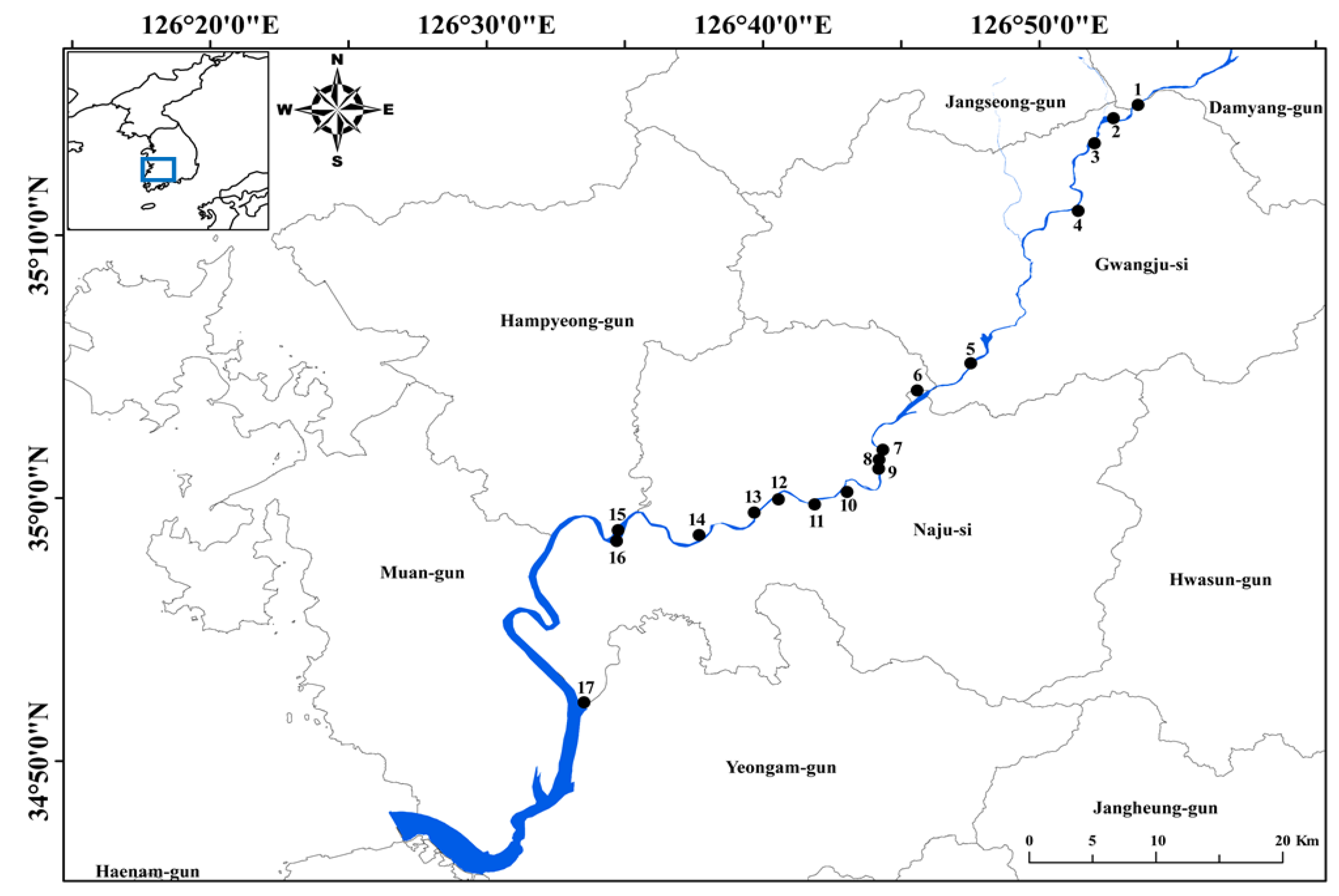

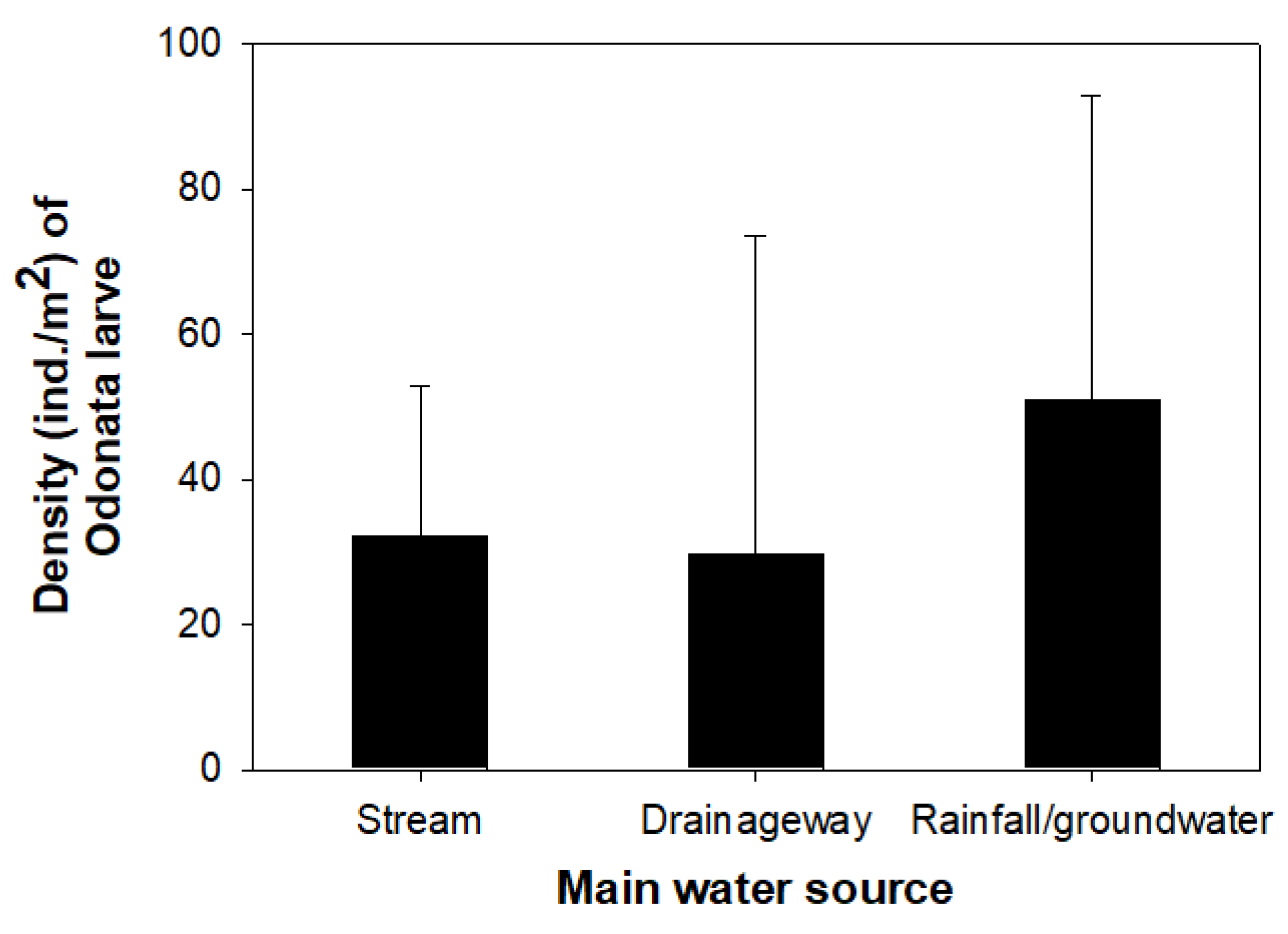
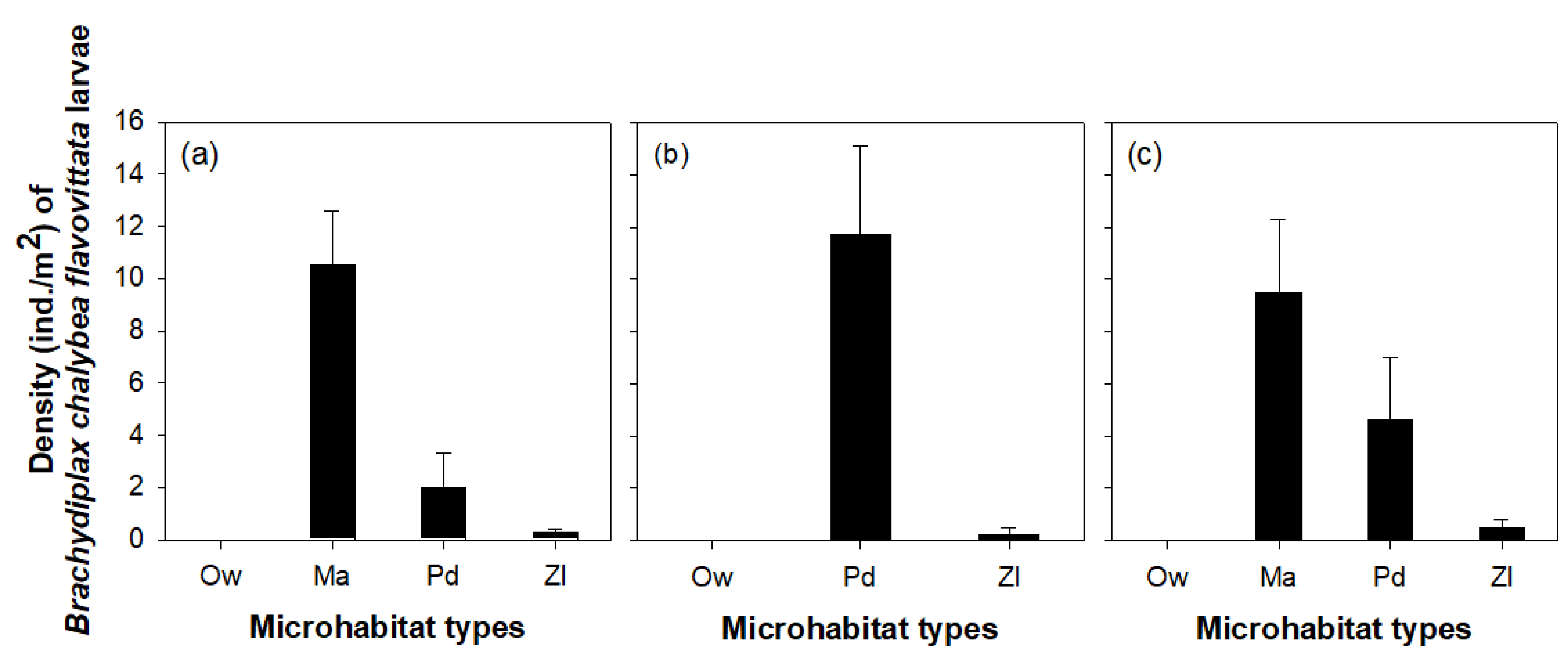
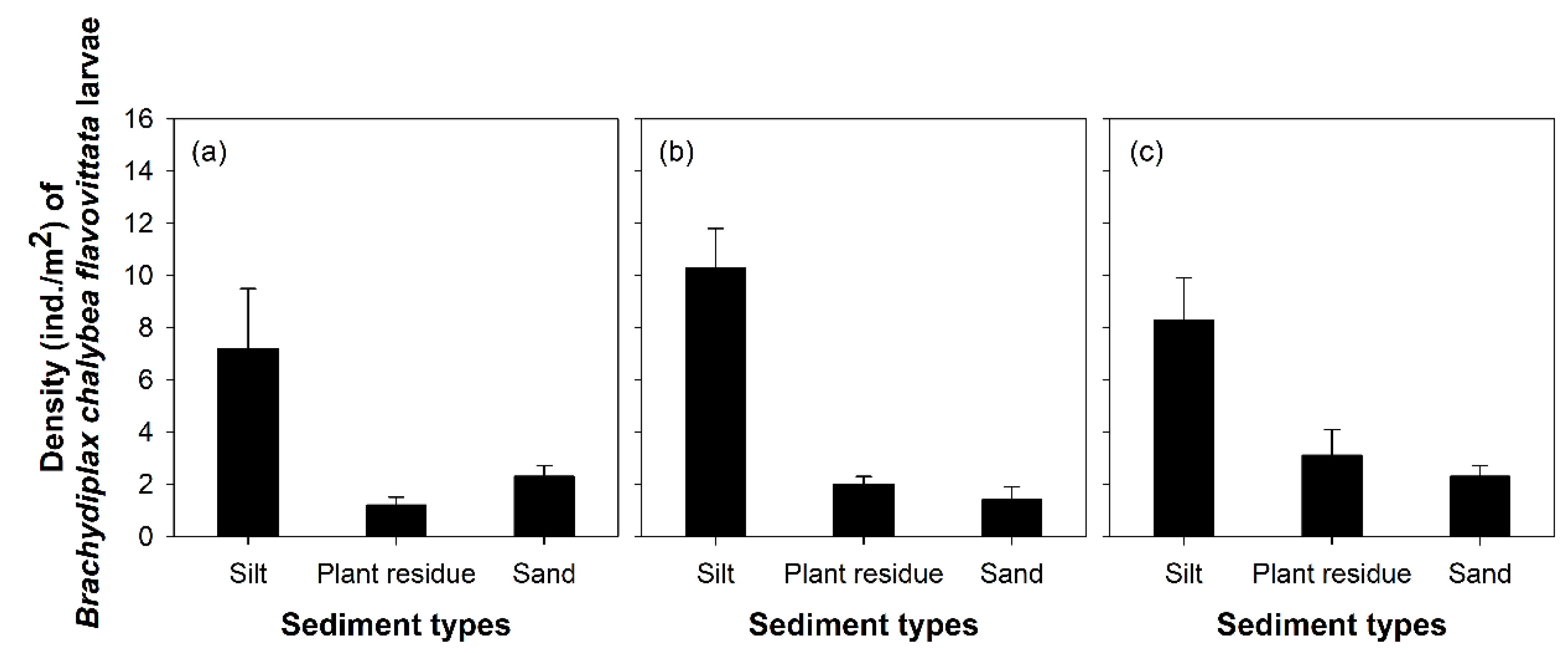
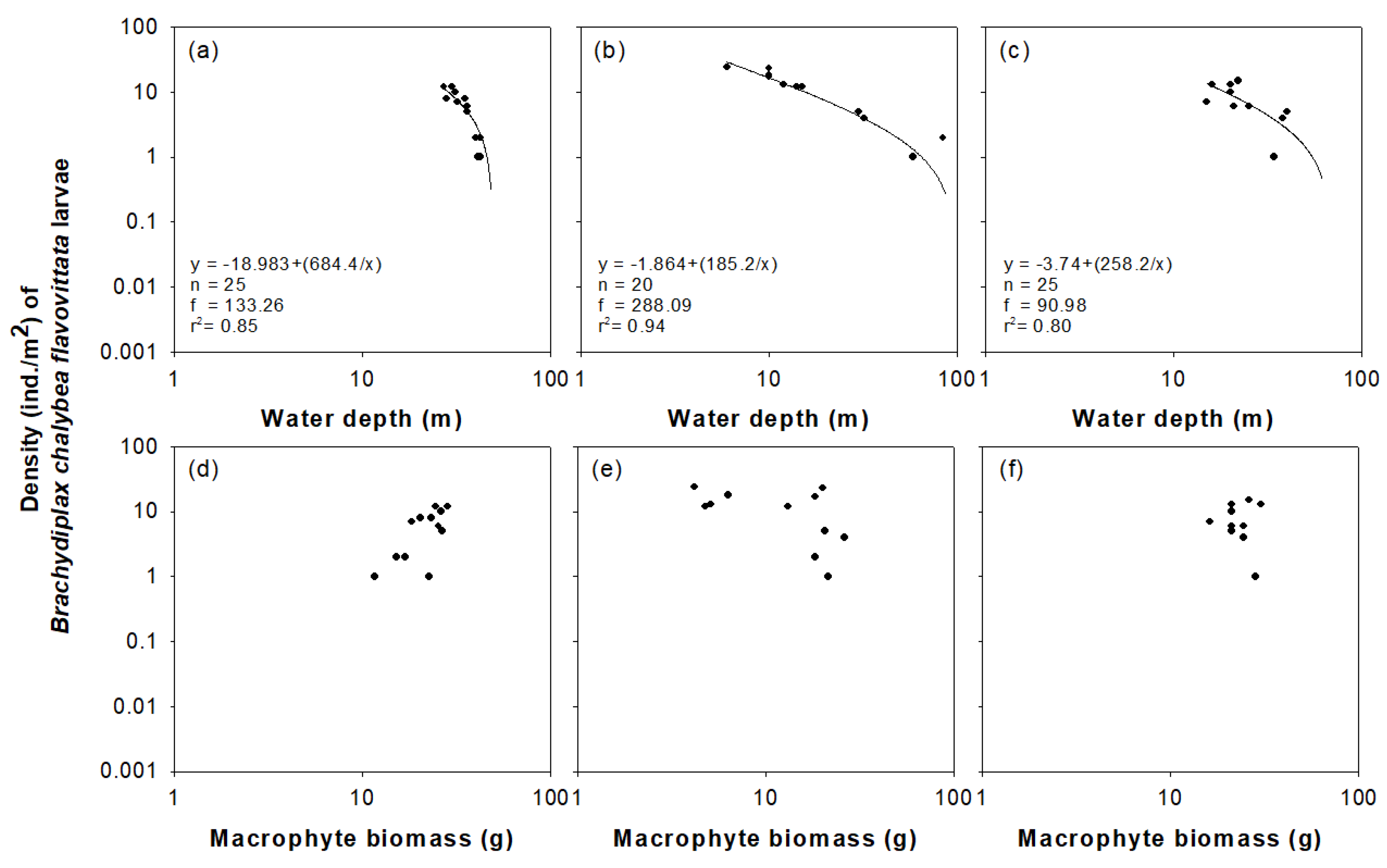

| No. | Main Water Source | Altitude (m) | Area (m2) | Fluctuation (m) | Mean Depth (m) | Maximum Depth (m) | Mean Residence Time (year) |
|---|---|---|---|---|---|---|---|
| 1 | Stream | 11.6 | 26,400 | 2.8 | 3.1 | 3.8 | 0.22 |
| 2 | Drainageway | 6.6 | 7800 | <1 | 2.8 | 3.1 | 0.32 |
| 3 | Stream | 16.4 | 13,700 | 2.5 | 2.7 | 2.9 | 0.31 |
| 4 | Stream | 18.2 | 20,400 | <1 | 4.1 | 4.6 | 0.16 |
| 5 | Rainfall/ground | 27.4 | 17,600 | <1 | 2.4 | 2.7 | 0.36 |
| 6 | Rainfall/ground | 23.2 | 6700 | <1 | 0.8 | 1.1 | 0.21 |
| 7 | Drainageway | 14.5 | 31,600 | <1 | 1.6 | 2.0 | 0.12 |
| 8 | Stream | 12.8 | 13,600 | 1.7 | 3.4 | 3.6 | 0.21 |
| 9 | Stream | 16.5 | 15,900 | 1.1 | 2.8 | 3.2 | 0.15 |
| 10 | Rainfall/ground | 9.2 | 22,600 | <1 | 1.2 | 1.8 | 0.43 |
| 11 | Drainageway | 11.8 | 25,600 | <1 | 0.7 | 1.6 | 0.41 |
| 12 | Stream | 20.7 | 4000 | 3.4 | 2.3 | 3.1 | 0.31 |
| 13 | Stream | 17.6 | 27,600 | 2.8 | 1.1 | 1.6 | 0.22 |
| 14 | Rainfall/ground | 26.7 | 350,000 | <1 | 0.8 | 1.4 | 0.42 |
| 15 | Stream | 24.3 | 137,957 | 1.7 | 1.8 | 2.2 | 0.18 |
| 16 | Stream | 30.5 | 109,000 | 2.5 | 1.6 | 2.1 | 0.11 |
| 17 | Stream | 24.7 | 137,957 | 1.4 | 2.3 | 2.7 | 0.37 |
| No. | WT (°C) | DO (%) | pH | Cond. (µS/cm) | Turbidity (NTU) | Chl a (µg/L) | TN (mg/L) | TP (µg/L) | MB (g) |
|---|---|---|---|---|---|---|---|---|---|
| 1 | 21.3 | 58.3 | 8.1 | 235.3 | 10.6 | 16.3 | 1.3 | 13.4 | 12.3 |
| 2 | 20.9 | 21.3 | 7.6 | 312.4 | 6.4 | 8.2 | 1.8 | 16.3 | 32.2 |
| 3 | 19.2 | 46.3 | 7.4 | 289.3 | 12.3 | 10.6 | 1.1 | 11.3 | 16.2 |
| 4 | 20.5 | 22.3 | 7.8 | 321.6 | 8.3 | 6.3 | 1.1 | 14.2 | 28.3 |
| 5 | 20.8 | 32.6 | 7.2 | 314.2 | 10.3 | 13.4 | 0.7 | 15.7 | 21.2 |
| 6 | 21.4 | 28.3 | 8.3 | 226.2 | 11.3 | 10.3 | 1.3 | 12.8 | 26.3 |
| 7 | 20.3 | 23.2 | 8.0 | 284.3 | 15.2 | 12.4 | 1.5 | 16.7 | 31.2 |
| 8 | 19.7 | 36.2 | 7.9 | 273.2 | 5.8 | 8.2 | 1.4 | 14.2 | 23.5 |
| 9 | 21.6 | 27.2 | 8.1 | 257.3 | 7.3 | 10.3 | 1.2 | 16.2 | 28.1 |
| 10 | 20.1 | 23.1 | 8.4 | 305.1 | 10.2 | 13.4 | 1.0 | 11.3 | 25.3 |
| 11 | 22.3 | 31.1 | 7.3 | 274.3 | 9.2 | 10.3 | 1.5 | 17.2 | 16.3 |
| 12 | 21.2 | 36.2 | 7.8 | 246.7 | 8.4 | 10.8 | 1.4 | 12.4 | 13.8 |
| 13 | 21.8 | 41.8 | 8.0 | 338.2 | 10.3 | 13.7 | 1.0 | 11.3 | 8.3 |
| 14 | 21.2 | 25.1 | 7.6 | 374.2 | 12.9 | 12.4 | 1.3 | 15.2 | 26.2 |
| 15 | 22.1 | 37.1 | 7.9 | 312.2 | 12.4 | 15.7 | 0.7 | 14.8 | 18.2 |
| 16 | 19.4 | 31.2 | 7.2 | 285.3 | 12.5 | 16.3 | 0.9 | 12.7 | 22.8 |
| 17 | 20.3 | 26.7 | 8.2 | 241.0 | 10.2 | 12.3 | 1.6 | 14.3 | 26.4 |
| Mean | 20.8 | 32.2 | 7.8 | 287.7 | 10.2 | 11.8 | 1.2 | 14.1 | 22.2 |
| SD | 0.9 | 9.8 | 0.4 | 39.6 | 2.5 | 2.9 | 0.3 | 1.9 | 6.9 |
| CV | 4.4 | 30.4 | 4.8 | 13.8 | 24.3 | 24.2 | 24.9 | 13.8 | 31.2 |
© 2020 by the authors. Licensee MDPI, Basel, Switzerland. This article is an open access article distributed under the terms and conditions of the Creative Commons Attribution (CC BY) license (http://creativecommons.org/licenses/by/4.0/).
Share and Cite
Choi, J.-Y.; Kim, S.-K.; Kim, J.-C.; Kwon, S.-J. Habitat Preferences and Trophic Position of Brachydiplax chalybea flavovittata Ris, 1911 (Insecta: Odonata) Larvae in Youngsan River Wetlands of South Korea. Insects 2020, 11, 273. https://doi.org/10.3390/insects11050273
Choi J-Y, Kim S-K, Kim J-C, Kwon S-J. Habitat Preferences and Trophic Position of Brachydiplax chalybea flavovittata Ris, 1911 (Insecta: Odonata) Larvae in Youngsan River Wetlands of South Korea. Insects. 2020; 11(5):273. https://doi.org/10.3390/insects11050273
Chicago/Turabian StyleChoi, Jong-Yun, Seong-Ki Kim, Jeong-Cheol Kim, and Soon-Jik Kwon. 2020. "Habitat Preferences and Trophic Position of Brachydiplax chalybea flavovittata Ris, 1911 (Insecta: Odonata) Larvae in Youngsan River Wetlands of South Korea" Insects 11, no. 5: 273. https://doi.org/10.3390/insects11050273
APA StyleChoi, J.-Y., Kim, S.-K., Kim, J.-C., & Kwon, S.-J. (2020). Habitat Preferences and Trophic Position of Brachydiplax chalybea flavovittata Ris, 1911 (Insecta: Odonata) Larvae in Youngsan River Wetlands of South Korea. Insects, 11(5), 273. https://doi.org/10.3390/insects11050273





